Is Puffer Fish A Biblical Clean Fish
BuildYourAquarium.com is supported by our readers. When y'all buy through links on our site, we may earn a commission. Learn more.
Freshwater Puffer Fish are extremely interactive and interesting fish. Although not the easiest type of fish to go on, puffers are unlike an other species in the hobby.
These fish are gorgeous and personable and make great "water puppy" pets!
This complete guide volition teach you everything you need to know near choosing, keeping, and caring for freshwater puffers.
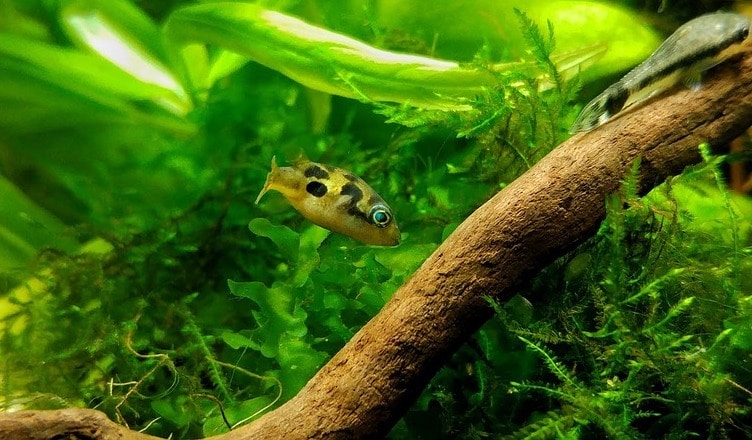
About Freshwater Puffer Fish
The term "freshwater pufferfish" refers to many different species.
Some of these require freshwater forever while others demand to be transitioned to brackish as they go. Pufferfish come in a wide variety, including fully brackish and marine.
This group of fish is extremely various, so we will delve into the individual care of several species in the "Common Species" section.
Nigh pufferfish are wild defenseless, and so internal parasites are a common malady, and then tend to be extremely sensitive to nitrogenous compounds. Nonetheless, the similarities betwixt all species does not go much further than this.
Temperament
The general dominion for keeping freshwater pufferfish is to keep them solitary. They are extremely aggressive fish, and even the pea puffer, which only grows to an inch long, will kill fish larger than itself.
They are equipped with a sharp beak to bite through the hard shell of mollusks, so they are capable of inflicting extreme harm on tank mates.
Some of the pufferfish we volition discuss can be kept with others of their ain kind, but you should ever accept a backup plan if you endeavor to mix other fish with your puffer(s).
Natural Habitat
Freshwater pufferfish come up from all over the world, only they tend to hail from very warm water. Excessive leaf is also common in their natural habitat, as are mollusks.
Without the essential mollusks, their beaks would grow and grow and abound until the upper half locked with the lower half, and the puffer would starve.
Freshwater Puffer Fish Species
Here we will hash out five common freshwater pufferfish species and how to intendance for them.
Pea Puffer

The pea puffer is unlike the other pufferfish in that you can find captive bred specimens.
The captive bred ones are hardier than the wild defenseless ones, aren't decumbent to internal parasites, and live longer than their compatriots.
Some other reason to purchase captive bred pea puffers is due to the severe reduction in natural populations caused past the aquarium trade.
In addition, they are more likely to thrive in your water, as convict fish experience more water changes than wild caught fish.
Males and females are differentiable by coloration. They are both very small and brown with darker chocolate-brown splotches. The males take neon green/metal wrinkles around their optics that the females lack.
In addition, the males often have a dark stripe downwards the middle of their bellies.
Mutual Illnesses
When buying your fish, make sure the ones you lot go accept full bellies without abnormal bulges. If any of the fish in their tank have sunken stomachs, treat for internal parasites with something like API General Cure or PraziPro.
Pea Puffers, and all wild defenseless fish, are prone to having internal parasites.
Tank Mates
Pea Puffers can exist housed in groups, unlike the other pufferfish.
That being said, they are extremely territorial, and you should provide at least 5 gallons for every pufferfish and heavily establish the tank.
BB Puffers do non coexist with other fish well and volition wipe out a community tank. While they are only 1", they take very sharp beaks and will decapitate and take chunks out of other fish.
They prefer horizontal space over vertical infinite because they establish territories based on horizontal space.
- Scientific Name: Carinotetraodon travancoricus
- Size: 1"
- pH: 6.5-7.5
- Temperature: 77-80°F
- Other Names: Dwarf puffer, Dwarf Indian Puffer, BB puffer, Pygmy Puffer
Food
Equally far equally nutrient goes, pea puffers are the easiest to provide for.
They do not require mollusks as part of their nutrition, though feeding pest snails is pop. Notwithstanding, the puffers oft but bite off the caput of the snail rather than crushing the shells.
Their primary diet in captivity is oftentimes worms. The worms vary from California blackworms, bloodworms, white worms, and tubifex worms. Pufferfish exercise non go later on pellets or dried food, so you volition have to provide alive food.
Some captive bred specimens volition eat pellets, but nearly BB puffers will non.
Congo Puffer
These fish are capable of changing color and do require crustaceans in their diet. On aspect of their care that is unique from other fish is their need for substrate.
Congo, or Potato, pufferfish need at least three inches of a deep sand substrate.
Congo puffers are ambush predators and spend virtually of their time buried, with only their eyes and a small part of their body exposed.
They also change coloration to match the substrate and are quite proficient at making these changes.
Tank Mates
Community tanks are a no-no, as this ambush predator will kill annihilation that moves. The other fish won't know what's happening until information technology is likewise tardily.
In the wild, they primarily consume fish, and so they will instinctually practice the same in aquariums.
Food
Their normal diet in aquariums tends to be based around shrimp and bloodworms.
Bloodworms are very fatty and should non be fed with every repast, and the shrimp should be large pieces from the grocery store, with the shell on.
They can likewise eat large ramshorn snails, Malaysian trumpet snails, pond snails, and other pest snails. Dissimilar the pocket-sized pea puffer, they will seize with teeth right through the shell and shred it.
- Scientific Name: Tetraodon miurus
- Size: three-6"
- pH: vi.5-7.five
- Temperature: 74-80F
Congo puffers should be kept in aquariums between 30 and 40 gallons, with a forty-breeder having perfect dimensions for them.
They should have some décor, such as driftwood, rocks, pebbles, and some vegetation, in club to assistance them experience secure.
Similar to other intelligent species, the Congo pufferfish have distinct personalities. Some keepers written report their fish enjoying sitting in their hand and responding to training, while others get bitten by theirs.
Each Congo puffer is different, but all are a joy to keep.
Fahaka Puffer
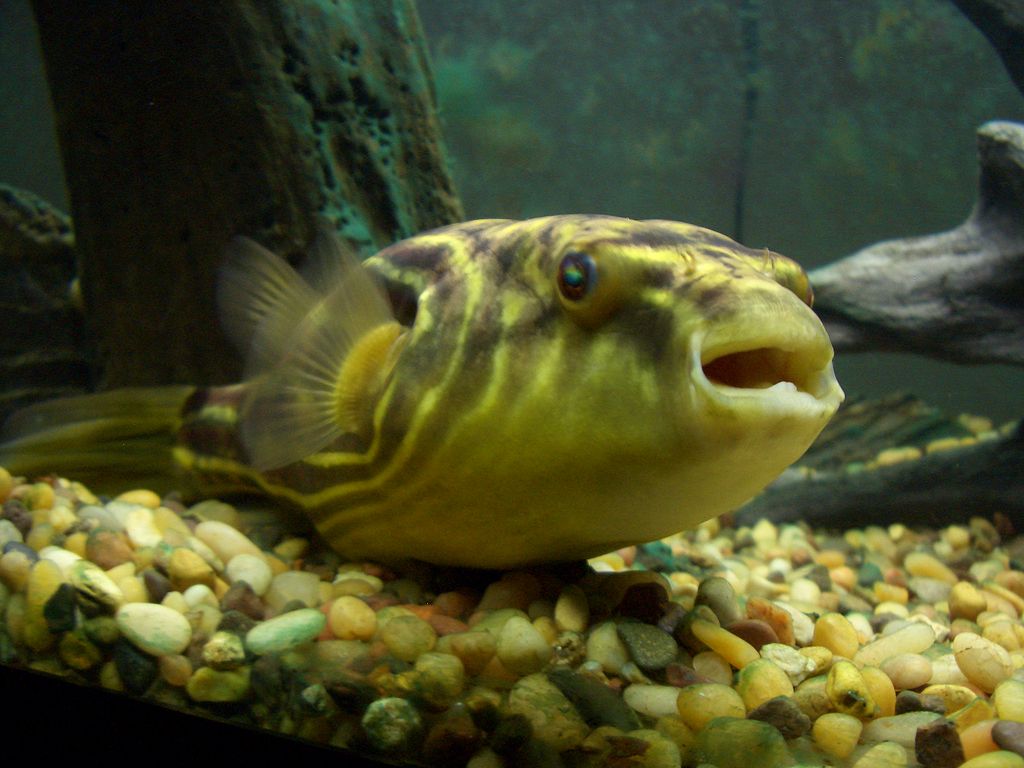
Those who keep these fish tend to do and then because of their alluring beauty and impressive size.
These are not for the boilerplate fish keeper, but they are for those who want to acquire monsters for their aquariums.
They must exist housed in a 120 or 125 gallon minimum, merely a larger tank may exist necessary depending on how large the puffer grows.
If it reaches 18", you will need a larger tank since the aforementioned tanks are only xviii" broad, not giving plenty room for them to turn.
Nutrient
In addition, their nutrient is very expensive. Their teeth must either be manually ground down, which is extremely dangerous for both you and your puffer, or be ground down naturally with tough foods.
Fahaka pufferfish are unremarkably fed clams, crabs, crayfish, worms, shrimp, and other mollusks.
The shrimp, crabs, and clams can be sourced from grocery stores, just must be uncooked and unseasoned.
You can also use feeder crabs, crayfish, and snails. For the Fahaka pufferfish, they must swallow different types of food at dissimilar stages in their lives due to the size deviation.
For example, young Fahaka puffers should exist fed ramshorn snails while large ones can consume mystery snails.
Equally for the worms, they often practice not take interest in bloodworms, blackworms, or white worms once they get large, but they always dearest nightcrawlers.
Nightcrawlers, blood-red wigglers, and earthworms are big and full of poly peptide.
- Scientific Name: Tetraodon lineatus
- Size: 14-18"
- pH: vii.0-viii.0
- Temperature: 76-80F
Eyespot Puffer
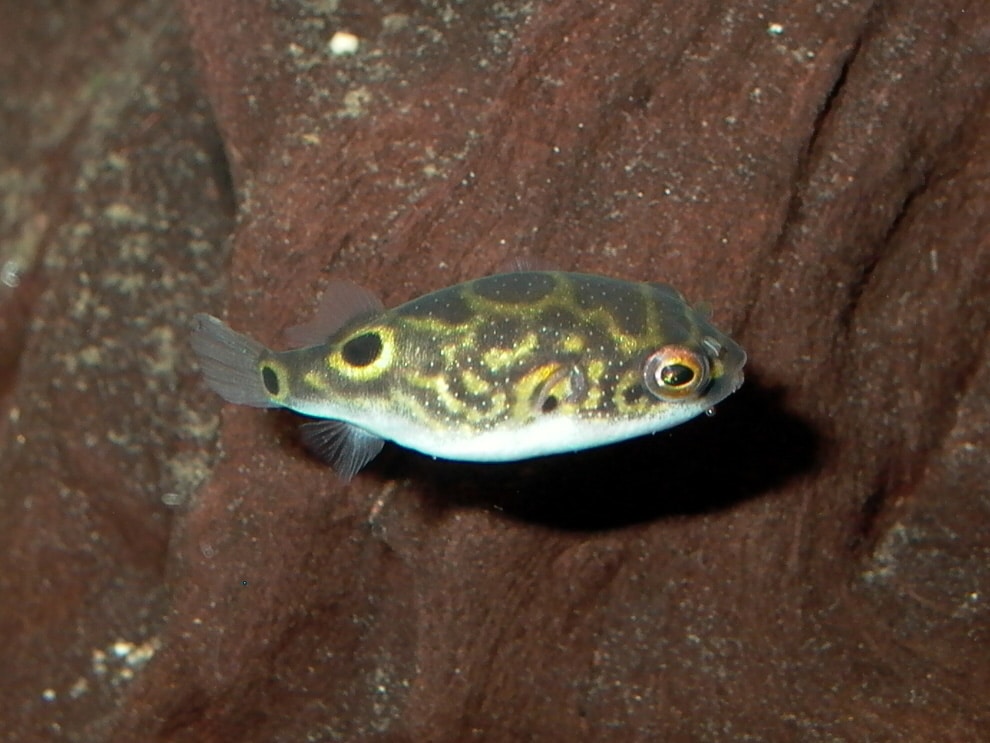
The eyespot pufferfish is also commonly referred to every bit the figure viii pufferfish.
Both of these names come from the spots on the dorsum of the pufferfish that resemble either two eyes or an viii.
Similar to the pea puffer, these are relatively small fish, often not surpassing three inches, simply similar the Fahaka pufferfish, they require live crustaceans in their diet to continue their teeth footing down.
At that place is a debate over whether or non these are a freshwater fish. Some argue that they live longer in brackish water while others state that freshwater keeps them healthier.
They are capable of existing in both types of h2o, just naturally come from freshwater.
Tank Mates
Very few keepers have reported some success in keeping the eyespot puffer in a community tank.
There is always a great risk that the puffer will kill all the other fish, merely some have been able to manage their aggressive nature.
Those that accept had success have used fish such as mollies and tetras, which are relatively large, fast, schooling fish. This suggests that keeping similarly big and fast fish may piece of work with your puffer.
Food
They should be fed hard-bodied food every day, such equally shrimp, clams, and other mollusks. These puffers often require live food, which is an result in a community tank, as they may hunt down their tankmates instead.
- Scientific Proper name: Tetraodon biocellatus
- Size: three"
- pH: 6.five-7.five
- Temperature: 75-79F
While many sources say a 15-gallon tank is a adept size, a xx long should be considered the minimum.
These fish are relatively active and territorial, so they appreciate any actress space y'all tin can give them.
Yous should provide them with rocks, driftwood, plants, and caves as hiding areas. Since they are modest fish, they are preyed upon in the wild and are much more comfortable having places to hide.
Red-eyed Puffer
Red-eyed pufferfish take strikingly striped gray bodies with brilliant red eyes. The males and females display drastically different patterns, and the females often await more vibrant.
This is another species of modest pufferfish, reaching but 2 or iii inches.
Tank Mates
These are fully freshwater without any surrounding debate. They are aggressive to their own kind and to every other fish, and then they cannot be housed in a customs aquarium.
If provided with plenty space (xx-long minimum), it is possible to keep a male/female pair.
Food
They must exist fed mollusks, shrimp, and snails to keep their beaks ground down. Since these will again be sourced from the grocery store (minus the snails), they volition likely be frozen.
This is a benefit, as it makes them fifty-fifty harder to chew, so it will wear the pecker downward faster.
Since they are small, the aquatic snails must not be besides large. Only equally the pea puffer tends to bite the head instead of the shell, the ruddy-eyed puffer will practise the same to large snails.
They must eat smaller pest snails to keep their teeth downward.
- Scientific Name: Carinotetraodon miurus
- Size: 2-3"
- pH: 6.0-eight.0
- Temperature: 77-80F
A xx gallon is a proficient starting size for these pufferfish, despite their small size. They tin can act very timid, so having a well planted/decorated large space means information technology is more likely that yous will see them.
Mbu Puffer
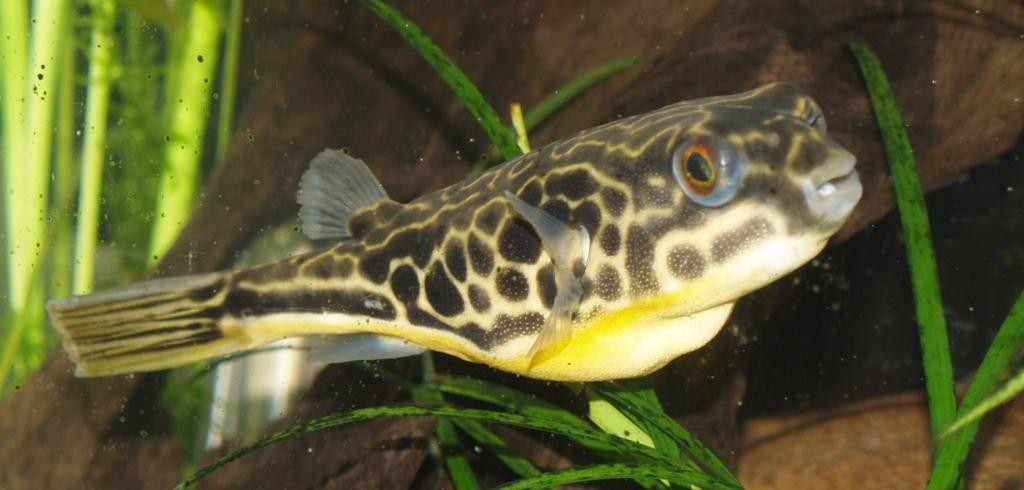
Just like the Fahaka, these pufferfish are not for the boilerplate aquarist. They get very big and swallow a massive amount of shellfish, which, every bit nosotros all know, is not cheap.
Mbu Pufferfish are very rare in the aquarium trade, and for good reason.
Nearly people exercise not take the ways or funds to take care of a fish that tin can potentially reach almost three feet long, hence the name, "giant pufferfish".
These guys will eventually need a custom aquarium built for them, and information technology is all-time to kickoff them out in a massive tank.
While the potential for three feet is in that location, about scarcely get over ii feet long. All Mbu pufferfish are wild defenseless equally they are currently incommunicable to breed in aquariums.
This is likely due to the lack of space for multiple three-human foot long fish and the disability to sex them.
Tank Mates
These are unique considering they can be housed with other fish, fifty-fifty at a massive size. One such case is Murphey, a Mbu Pufferfish at Aquarium Co-op, that is housed with guppies in a 360- gallon aquarium.
Food
The Mbu puffers do have an effect with nib growth, so they need daily mollusks, shrimp, crayfish, and snails, only like other puffers.
Due to their large size, at that place is a benefit to feeding them nutrient that is still frozen.
Tank size for this fish is a widely debated topic. Since it volition likely have to exist a custom aquarium, it is best to brand information technology as long as wide as possible and make information technology relatively brusque, only two or and so anxiety.
Since puffers adopt horizontal infinite over vertical space, a long and broad aquarium will better house your fish. It will also be much easier for yous to make clean.
Since pufferfish shred their casualty, they make a huge mess that y'all will have to make clean frequently.
- Scientific Proper name: Tetraodon mbu
- Size: 24-30"
- pH: 6.0-8.0
- Temperature: 76-80F
Pufferfish Care
Here are some central tips you should know earlier attempting to keep Pufferfish:
Water Parameters
Each species has a slightly different requirement for water parameters, so we will talk over them with their corresponding species.
Even though they do have ideal parameters, information technology is more important to have stable parameters rather than "perfect" ones.
Is your water a little also hard? A picayune also soft? The pH a bit too low? Information technology'due south better to leave the parameters just how they are rather than fiddle with them.
In improver, acclimating your pufferfish is essential. For these sensitive little fellows, baste acclimation is by far the best choice.
Float the bag they are in at the top of the tank, simply at the same fourth dimension, open it, remove some of the water, and begin dripping aquarium h2o in.
The easiest fashion to practise this is to get a pitcher or like container to a higher place the bag with airline tubing in it. Either tie a knot in the airline tubing or utilize a control valve so that it only drips out 1-3 drops per 2nd into the bag.
This will slowly allow your pufferfish to accommodate to their new water parameters and should take at least half an hour. Allow the water in the bag to double, then remove one-half, then let it double over again.
You lot can and then add your fish to its new habitation, only information technology is best to avoid calculation any of the water from the shop, as information technology may incorporate medications and pathogens.
Nitrogen Sensitivity
All fish are sensitive to ammonia, nitrite, and nitrate, which is why it is essential to fully cycle your tank earlier adding fish.
Be sure that you have a consummate agreement of the nitrogen wheel and testing kits before calculation fish to your aquarium.
Virtually aquarium fish sold in pet stores volition survive some levels of ammonia or nitrite for brusk periods of time (ane to 3 days), but pufferfish will non. This is partly due to the fact that they are wild caught.
In the aquarium trade, fish will be exposed to nitrites and ammonia at some point or other.
Over fourth dimension, the ones with the strongest resistance ended upwards breeding and create fish that are somewhat resistant to suffocation and burning acquired by these nitrogen compounds.
However, ammonia, nitrite, and fifty-fifty nitrate are not often plant in the wild. If you want, go and test local rivers, streams, lakes and ponds, and come across what you can find.
Chances are, at that place won't be any nitrogen compounds that you lot exam.
Since pufferfish accept not yet been exposed to lethal ammonia and nitrite, any trace amounts volition impale them very quickly. They are especially sensitive to nitrites, but fully cycled tanks should never have nitrites or ammonia.
However, most fish can handle 20-40ppm nitrates, but with pufferfish, information technology is best to continue them every bit low as possible, such equally 10ppm or less.
Nutrition
With the exception of the pea puffer, all of these fish need to eat shelled creatures very regularly.
They also demand a widely varied nutrition, so yous can feed anything from shrimp to clams to freshwater snails.
Shrimp and other shellfish can exist acquired from the local grocery store, but they cannot take any sort of seasoning and should be raw.
If they are cooked, they are often cooked in certain oils or other seasonings that may not be listed and could harm your fish.
Pea puffers are normally fed aquarium "pest" snails such as ramshorns, Malaysian trumpet snails, swimming snails, and bladder snails.
They cannot subsist off simply snails, merely they can exist a staple part of their diet. If you are primarily feeding snails, you should aim for two-4 a solar day.
Worms are also an essential part of a pea puffer'due south nutrition and are a good supplement for other pufferfish likewise.
The worms should exist live and range from California blackworms to tubifex to bloodworms and white worms.
Setting up a Pufferfish Tank
Interesting in keeping pufferfish? Hither are some things y'all will demand to consider:
Choosing a Substrate
Most of these pufferfish will prefer a sand substrate, which is what they would observe in the wild. The add-on of rocks and pebbles can help them feel more secure, peculiarly for the Congo puffer, which may endeavour and replicate the color of a rock.
Adding Live Plants
Since pufferfish are carnivorous, they do not prey on plants, and therefore make a great inhabitant of a planted tank. Most of them also feel much more than secure in a planted tank, especially the small ones similar pea puffers.
Here is a listing of undemanding, easy aquarium plants that will describe out your puffer's personality even more:
- Ludwigia
- Anacharis (Brazilian H2o Weed)
- Scarlet Temple
- Pennywort
- Banana Plants
- Ruby-red Root Floaters
- Coffee Fern
- Hornwort
- Anubias
- Java Moss
- Subwassertang
- Rotala
- Christmas Moss
- Dwarf Sag
- Vallisneria
- Amazon Sword
Pea puffers absolutely adore plants, and some consider a planted tank essential for them. Plants also help remove nitrogenous waste, and since puffers are so messy and yet and then sensitive, they can really assist you lot in your boxing against nitrates.
Cycling
Pufferfish volition die if there is even the slightest amount of ammonia or nitrite. These are not present in fully cycled aquariums, and to make sure y'all go information technology right, we volition break down what cycling is.
One time y'all add an ammonia source, bacteria will begin to convert it to nitrite and so nitrate, merely this process takes around a month.
You must dose ammonia, if y'all are using pure ammonia, at a rate of 4ppm until nitrites appear, then dose at 2ppm.
You tin as well wheel the tank using other methods, just the ammonia method is the nearly successful. Information technology is cruel to use fish to bike the tank, as they suffer irreversible damage.
Y'all could also throw in a piece of shrimp or fish to bicycle it, but this method stinks, literally.
Even though yous have to wait, you can get ahead and set up your tank with plants, rocks, and driftwood!
This is your adventure to get it perfect earlier y'all add together your fish because, trust me, it is much more hard to rearrange your tank once it has fish.
In add-on, the plants will deport in some leaner that aid convert ammonia to nitrite to nitrate, so it tin fifty-fifty help speed upwardly your cycle.
At the very least, they will help keep your tank stable later on the cycling is washed.
Breeding Pufferfish
What's better than a super happy and personable pet pufferfish? Infant pufferfish!
Which Pufferfish Species Can You Breed?
Unfortunately, most of these species have never been bred in captivity. Those that have are nonetheless few and far between, and the procedure is not well documented.
The pea puffer, figure 8, red-eyed pufferfish take been bred in captivity, though success is limited.
All these pufferfish are egg layers, and then having either a spawning mat or spawning surface is necessary. Some breed in group tanks, while others need other tanks to spawn in.
Since they are already being fed loftier protein diets, conditioning is not necessary.
Pea Puffers
Since pea puffers can be housed together and should be kept in densely planted tanks, spawning may occur naturally. The male tends to lead the female to an area he deems secure, then they spawn there.
The area is unremarkably a institute or group of plants. However, the babies may presently become nutrient for any other puffers in the tank, including the parents.
You can either attempt to spawn them in a separate tank, remove the plants with the eggs, or remove the adult puffers.
Young pea puffers are incredibly modest, and oftentimes too small to eat infant brine shrimp. You should brainstorm by feeding them infusoria, copepods, immature daphnia, microworms, and vinegar eels.
It should not take more than a few days for them to exist able to eat baby brine shrimp.
As they grow, you should begin putting baby ramshorns in with the babies to start them on some kind of hard food.
Baby ramshorns besides hatch out at extremely pocket-size sizes, so if you are able to transfer some egg sacks, they would assist the babies immensely.
Figure 8 Puffers
Very little is known about breeding figure 8 puffers, but some merits that they must be bred in brackish water.
In that location are some reports of the male exhibiting parental care to the eggs and fry for about a week.
The babies will likely need alive nutrient similar to the pea puffers and should be transitioned to baby brine shrimp equally before long every bit possible.
Afterwards baby brine, worms (every bit white worms, blackworms, tubifex, and bloodworms), daphnia, and snails should be added to the diet.
Ruby- Eyed Puffers
Like to the other babies, babe red-eyed puffers cannot exist fed brine shrimp outright. They can swallow the same recommended nutrient as the others.
The ruddy-eyed pufferfish is known to have an elaborate courting dance, during which the male tries to entice the female.
If he succeeds, she will release eggs over plants or a spawning mop which the male will then fertilize.
Just like the Figure viii pufferfish, the male scarlet-eyed pufferfish will display parental care for the eggs.
The male volition fan the eggs and guard them until they hatch to protect them from fungus and predators akin.
Source: https://www.buildyouraquarium.com/freshwater-puffer-fish/
Posted by: mcmullenwhinevesock1945.blogspot.com

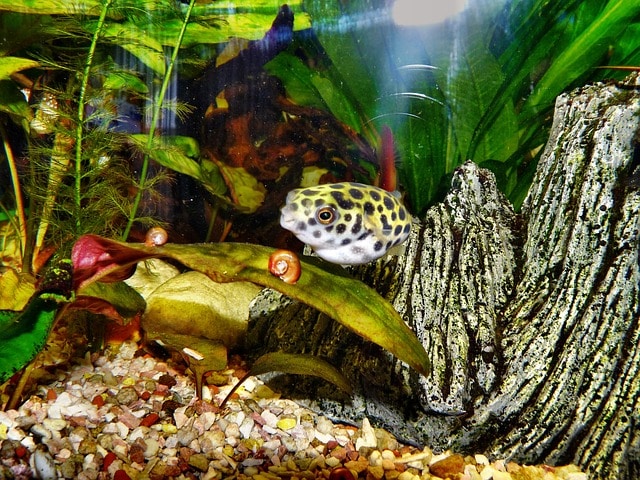


0 Response to "Is Puffer Fish A Biblical Clean Fish"
Post a Comment